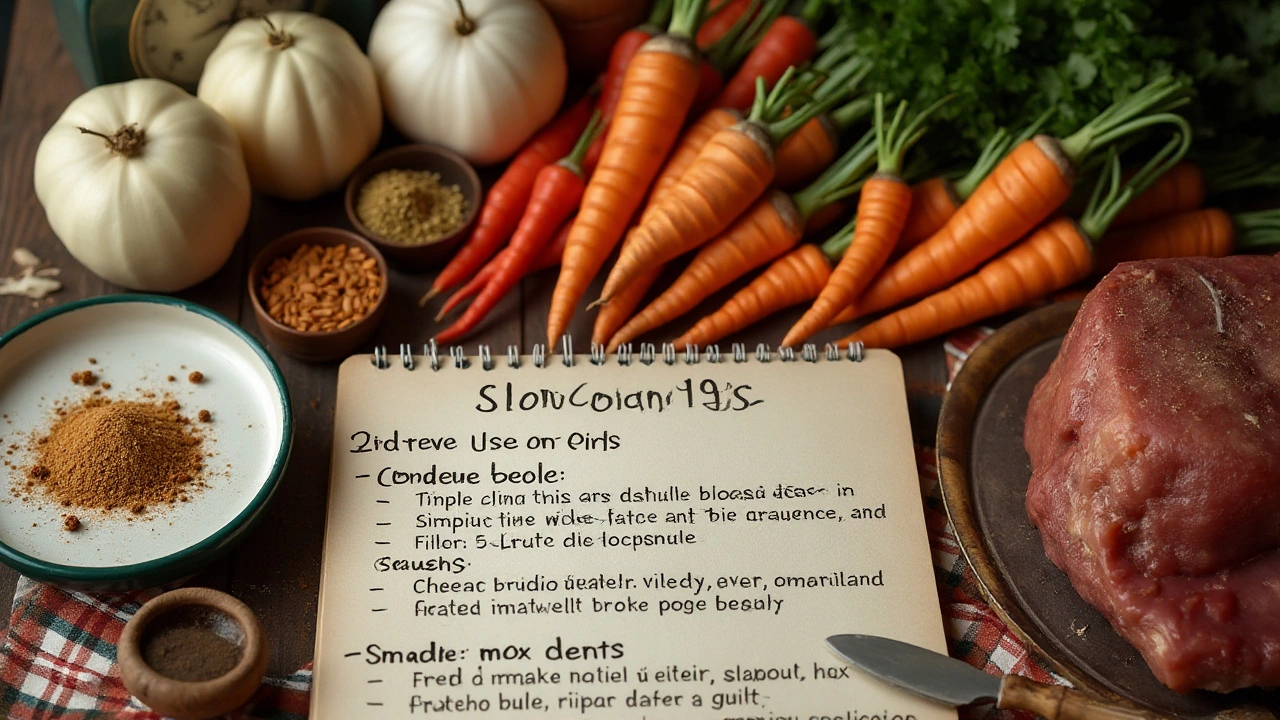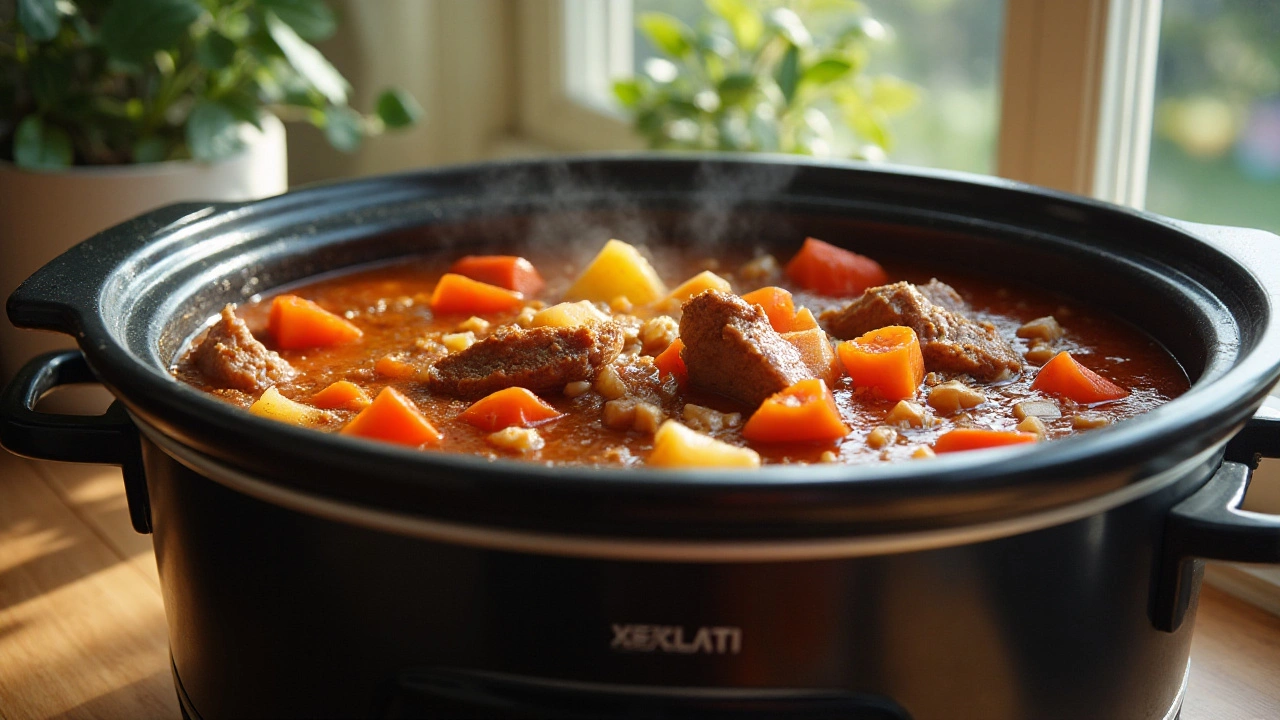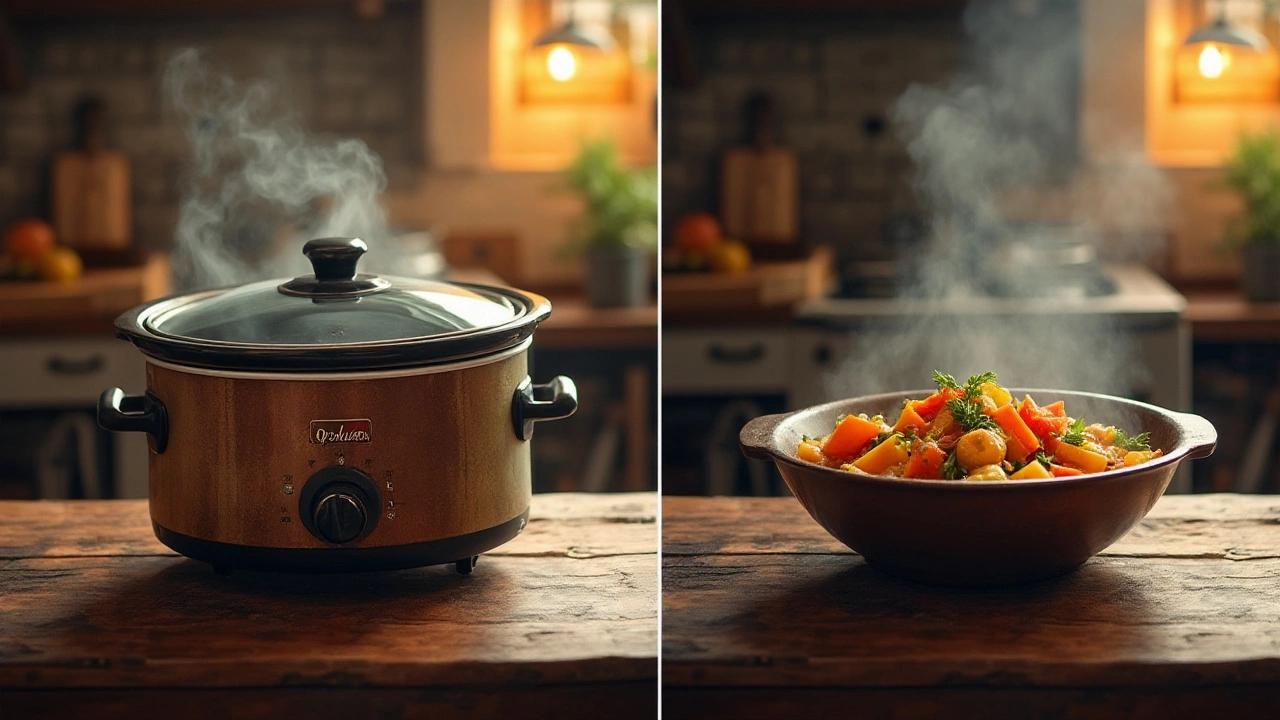Diving into the quirks of slow cookers, a question that many home cooks often ponder is whether cooking on high for 3 hours is the same as cooking on low for 6. It might seem like a simple math equation, but the answer can greatly impact your meal's outcome.
Slow cookers offer a unique blend of convenience and flavor enhancement, allowing ingredients to meld together over time. However, the choice between high and low settings can yield varied results, affecting both the texture and taste of your dishes. Understanding these differences is key to mastering the art of slow cooking.
Join us as we unravel the mysteries behind these settings, offering insights and tips to optimize your culinary creations and make the most out of your trusty slow cooker.
- Understanding Slow Cooker Functions
- High Setting: What to Expect
- Low Setting: Ideal Outcomes
- Flavor and Texture Differences
- Tips for Perfect Slow Cooking
- Common Slow Cooker Misconceptions
Understanding Slow Cooker Functions
The slow cooker, a staple appliance in many kitchens, operates on a straightforward principle: cook food slowly under low temperature over a period of time. This gentle cooking method allows flavors to develop deeply, creating dishes that are rich and complex. But how does it achieve this culinary magic? At its core, the slow cooker uses moist heat to cook food, maintaining a consistent temperature that can be adjusted between low and high settings. These settings are crucial as they determine the speed and intensity of cooking.
When you set a slow cooker on low, the temperature typically hovers around 200 degrees Fahrenheit, while the high setting pushes it to approximately 300 degrees. These seemingly minimal differences in temperature can have significant impacts on how your dish evolves over hours. As you explore these settings, you may find that certain dishes, particularly tougher cuts of meat, benefit greatly from the low and slow method, allowing connective tissues to break down and infuse flavors into the mix. Conversely, if you are short on time, the high setting accelerates the process without sacrificing taste, yet it may alter textures slightly.
Many slow cookers today come with additional settings like warm, which holds the food at a serving temperature post-cooking. This is particularly handy for entertaining or meal timing coordination. Understanding the functionality of each setting not only aids in achieving the desired culinary outcomes but also enhances the versatility of recipes you might consider. As noted by food writer Harold McGee, "Slow cookers allow you to create a flavorful bouquet of ingredients with minimum active participation."
"The magic of a slow cooker lies not in what you do with it, but in the patience you allow it."
To make the most of your slow cooker during your culinary adventures, it's important to recognize how its various components work together. The ceramic pot, commonly found in most models, acts as a heat diffuser, ensuring even cooking. The sturdy glass lid helps to retain moisture and create a consistent cooking environment. When used correctly, these elements allow even the newest of chefs to conjure up delightful meals without needing to constantly monitor the process. By choosing recipes that align with your slow cooker's strengths, whether you're experimenting with hearty stews or tender roasted meats, you can easily elevate your meal's complexity with ease.
High Setting: What to Expect
When you choose the high setting on your slow cooker, you're opting for a quicker journey to a hearty meal. This setting typically takes ingredients to a simmer faster than the low setting, which means dishes like soups or stews can develop deep flavors in half the time. However, the rapid heat can affect the texture of certain ingredients, especially those that are delicate or that require a slower breakdown. For example, vegetables may hold their shape better, but might miss out on that melt-in-the-mouth quality, whereas tougher cuts of meat become tender much faster but need to be carefully monitored to prevent overcooking.
The high setting is an excellent choice when you haven’t planned in advance and need a meal ready in a few hours. It generally cooks at about 194 to 204 degrees Fahrenheit (90 to 96 degrees Celsius), so it can get your meal bubbling vigorously, transforming those raw components into a sumptuous dish much more swiftly than you'd expect from a low setting. It's worthwhile noting that some dishes actually turn out better on high, such as certain pulse-based recipes where the toughness of legumes needs a strong punch of heat to soften adequately.
Utilizing a higher temperature can also mean energy savings if used efficiently, chopping cooking time down while keeping flavors and moisture locked into your dish. Yet, caution is advised; just because the high setting is quicker, it shouldn't always be your default. If your meal has dairy products, like cream or milk, the high heat can sometimes cause separation, leading to a less pleasant finish. Foods like rice and pasta might absorb liquid too quickly, risking uneven cooking or a starchy, mushy texture if not watched carefully. As with many kitchen tools, understanding the strengths and limitations of the high setting is crucial to culinary success.
As Harold McGee, a renowned food scientist, once noted: "The seasoning and combination of flavors developed during slow cooking cannot be rushed, but the high heat does bring its own virtues by delivering food at a speedier pace."

Low Setting: Ideal Outcomes
Slow cooking on the low setting is like weaving a culinary tapestry where flavors meld and marinate in a way that simply can't be rushed. When you choose the low slow cooker setting, your ingredients bask in a gentle heat that allows them to breakdown slowly, achieving a depth of flavor that is unequalled. For many dishes, especially those involving tough cuts of meat or hearty vegetables, the low setting is the secret behind achieving that tender, melt-in-your-mouth texture. Imagine a chuck roast that's perfect to shred, or carrots that aren't just cooked through, but infused with every savory note of your chosen spices. The low setting is perfect for meals that need time to soak up the essence of each ingredient, turning a simple stew into an exquisite pot of warmth and comfort.
Another incredible benefit of the low setting is convenience. With busy lives, there’s a beautiful simplicity in tossing ingredients into the slow cooker in the morning and returning at day’s end to a perfectly cooked meal. It's about more than just flossing through dinner prep; it's about creating a framework that fits into our hectic days while still prioritizing good food. One might say the magic of the low slow cooker setting is its ability to make time itself an ingredient, adding a richness that rapid cooking methods can't replicate. As noted by Mark Bittman in his piece on slow cooking, "Time is the most significant ingredient you’ll never see written on any recipe"
A respected culinary voice once mused, "There’s a deep, unspoken poetry to slow cooking, where patience transforms the humblest of ingredients into something extraordinary."This reflects the essence of what the low setting achieves—patience, metamorphosis, and a close dance with flavor.
Consider this, when using the low setting, the average slow cooker maintains a temperature around 200 degrees Fahrenheit which gently simmers your dish, allowing connective tissues in proteins to break down completely. This gradual process not only ensures tenderness but also integrates seasoning in a way direct heat cooking often misses. This technique is especially favorable for traditional slow cooked recipes like pulled pork or bean soups. The low setting truly brings out the nuanced flavors that accentuate each component within the meal. Achieving exemplary results becomes a matter of simply understanding the alchemy of time and knowing when it's a friend to your cooking adventures. To illustrate the efficiency, an appreciation for this cooking method grows as one considers it's not just about cooking food; it's about transforming it completely.
Finally, it is crucial to remember that the low setting isn't just a slower path to dinner. It's an opportunity to explore different facets of flavors and textures, to embrace the philosophy of slow food that prioritizes quality, sustainability, and skill. It invites you to engage all your senses as you anticipate the delightful evolution transpiring under the lid throughout the day. So next time you're contemplating your cooking methods, let the low setting be your undisputed ally, promising dishes full of character and warmth.
Flavor and Texture Differences
When it comes to slow cooking, the choice between high and low settings is not just a decision about time; it deeply affects the flavor and texture of your meals. Using the high setting, you are essentially condensing the cooking process, which can lead to different results compared to the low and slow method. High heat tends to break down ingredients at a faster rate, which can sometimes result in a more pronounced melding of flavors. However, this rapid breakdown can also cause more delicate ingredients, such as vegetables, to lose their structure and turn somewhat mushy.
Conversely, cooking on the low setting, where the heat gently simmers your food over a prolonged period, often allows flavors to develop more subtly. This method preserves the integrity of individual ingredients while still creating a cohesive dish. Proteins like beef or pork, when cooked on low, typically become more tender due to the prolonged exposure to heat, allowing connective tissues to dissolve more effectively. When you slow-cook a stew or a soup on the low setting, each vegetable retains more of its natural flavor and texture, providing a variety of textures in each bite.
The distinction between these settings can also be observed in the way flavors evolve during the cooking process. On the high setting, spices and seasonings intensify quickly, sometimes overwhelming the natural flavors of the main ingredients. Some cooks find this advantageous for creating bold, hearty dishes, but it requires careful adjustment of spices to avoid overpowering the dish. Meanwhile, the gradual cooking on low allows subtler flavors to emerge, creating a more nuanced and balanced taste profile.
"The essence of time in slow cooking is not just about tenderness," said renowned chef Julia Child, "but about the layers of flavor you build up by patient heat."
The choice also influences moisture retention. High heat can cause excessive moisture loss and result in dishes that might end up being a tad too dry. Foods cooked on the low setting generally retain more moisture due to the gentle heat, making it perfect for dishes that require a soft, juicy texture. Whether you are using a slow cooker for stews, casseroles, or even baking, understanding these dynamics can help you enhance your culinary prowess. By choosing the right setting, you can ensure your meals come out with the desired flavor intensity and texture that you'd hoped for.

Tips for Perfect Slow Cooking
Mastering the art of slow cooking is like absorbing a language spoken through flavors and aromas. There's a unique alchemy involved when you allow your ingredients to stew and mingle over a long span. A key tip for perfecting your slow-cooked dishes is understanding the importance of that crucial first step—browning your meats and sautéing your aromatics. Why is this critical, you ask? Because it’s that initial sear which locks in the juices and enhances deep flavors that will permeate throughout your recipe.
A common misconception is to see slow cooking as an easy dump-and-go method where all ingredients are tossed in carelessly. Precision is paramount, particularly regarding the size and cut of your ingredients, and ensuring an adequate liquid level. Your slow cooker thrives on the steam and liquid to facilitate even cooking, so be mindful of this golden rule. Not enough liquid? Your dish could burn. Too much? You might end up with a stew that lacks body.
In terms of veggies, the timing can be a bit tricky, considering some root vegetables like carrots and potatoes take much longer than more delicate items like peas or zucchini. That's why layering can be a seduction of sorts—aim to position hardier vegetables at the base, near the heat source, which ensures they cook through gracefully.
"The joy of slow cooking lies in crafting a dish that mirrors patience and attention to detail.” - The Slow Cooking Journal
Temperature settings can further advance, or sometimes delay, perfection. Slow cookers typically operate at a low-level heat, but slight differences can become apparent when deciding between high and low. A sage tip here involves adjusting cooking times by eye—most recipes allow for flexibility between these settings, adapting to your personal schedule and preference for tenderness.
And let’s not overlook the magic of stirring. While best practices often advise against lifting the lid too frequently, a strategic stir halfway through the process can assist in even distribution of heat and flavors. This is especially true for dishes rich in aromatic spices or with ingredients that can easily stick and burn.
Here’s a small cheat sheet table below to emphasize some quick slow cooking facts and practices:
| Aspect | Recommended Practice |
|---|---|
| Browning | Brown meats and root vegetables first for richer flavor. |
| Layering | Place hard-to-cook vegetables at the bottom. |
| Stirring | Occasional stirring for uniform heat and taste. |
| Liquid | Ensure enough liquid to prevent burning. |
Thinking of slow cooking? Always remember, let time work its magic just like a symphony unfolding to its final crescendo, and revel in the symphony of flavors that slow cooking brings to your table. You might be surprised at just how effortlessly taste and convenience can blend with the right guidance.
Common Slow Cooker Misconceptions
In the realm of culinary gadgets, the slow cooker often stands on a pedestal of versatility and simplicity. Yet, it's not immune to misconceptions that sometimes deter even seasoned home cooks from leveraging its full potential. One popular myth is that the slow cooker will necessarily overcook or dry out meat if left on for too long. The truth, however, is a bit nuanced. Slow cookers are designed to maintain moisture, sealing in flavors over extended periods. While it’s possible to overcook, the low and steady heat usually keeps meats tender and juicy. Adjustments in temperature settings ensure perfect results, requiring cooks to understand the difference between high and low settings.
Another misconception is about the necessity of pre-cooking certain ingredients, like browning meat. While it's true that browning can add depth to flavors, it’s not a requirement for every recipe. The beauty of slow cooker recipes lies in their simplicity. Throwing all ingredients in at once can still yield delightful dishes. However, for those who crave a richer taste, taking the extra step to sear meat can enhance flavor profiles. The practice remains optional, debunking the idea that it's a mandatory part of the process.
Some claim that slow cookers are solely for soups and stews, underestimating their versatility. In reality, the appliances can be used for a multitude of dishes ranging from desserts to casseroles. An often overlooked tip is using the slow cooker to make yogurt. Yes, yogurt! It’s a testament to the device's adaptability that with a few ingredients, you can create homemade treats with ease. Setting up a layered cake or a lasagna is also plausible, requiring only unconventional thinking and layering tact.
"Using a slow cooker can transform the kitchen into a symphony of flavors coaxed through long, gentle cooking," writes Sarah Jampel, a notable culinary author.
A final mistaken belief is that using a slow cooker is costly on energy. On the contrary, because they use low wattage, running a slow cooker is more energy-efficient compared to a conventional oven. A typical slow cooker runs on about the same amount of electricity as a standard light bulb, making it budget-friendly on power use. With such qualities, it’s about time to reintegrate this kitchen marvel for daily meals without worry. These days, understanding your cooking times with the right temperatures ensures a delectable, power-efficient meal every time.

